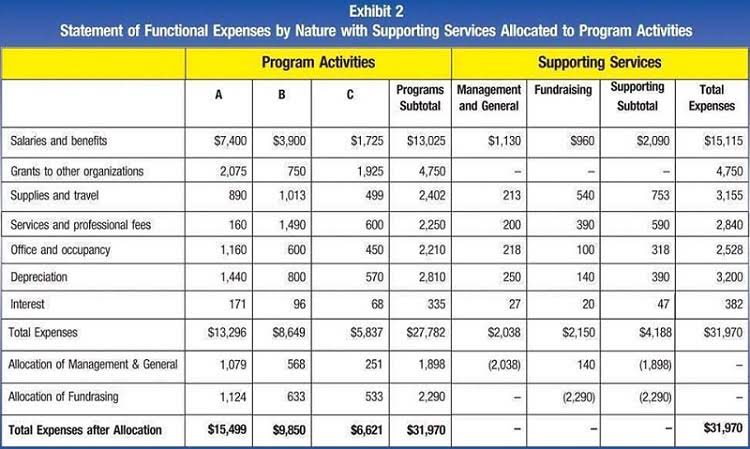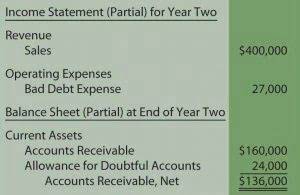
This complete suite of modules is often referred to as an enterprise resource planning (ERP) system and can manage the entire operations of an enterprise. For instance, Wave provides free accounting software with a range of essential features for managing your financial data. Other companies, such as Zoho, provide a free basic version of their accounting software. During my research and testing to identify the best accounting software for small businesses, I took advantage of available demos and free trials, examined materials on corporate websites, and combed through user reviews.

Importance of Accurate Manufacturing Accounting for Businesses
- We actively embrace artificial intelligence technology and humanoid robot facilities to improve production efficiency.
- A new AI chatbot can help you analyze your finances and anticipate follow-up questions.
- Many on-premises, perpetual license options come with an implementation fee that is cost-prohibitive for small businesses.
- Although it is not a full ERP system, it can integrate with QuickBooks Online and Xero for accounting and other third-party software for automation, CRM, ecommerce, and reporting.
- QuickBooks Enterprise Diamond is the most powerful QuickBooks Enterprise product.
Many ERP solutions include an accounting solution to streamline operations. However, an ERP system can also be pricey, especially for small manufacturers or startups. Many manufacturing ERP solutions offer a core plan for a per-user price, then options to add modules to expand its functionality for an additional price.

Direct labor
Modern-day solutions help you automate tedious accounting processes, manage your company’s finances, and stay in compliance come tax time. However, to reap the benefits of accounting software, small-business owners must sift through the many brands on the market to figure out the best program for their needs. Manufacturing manufacturing accounting businesses face various challenges in their business process, such as procurement, project management, finance, inventory, and more. That’s where an ERP for the manufacturing industry like Business Central or Dynamics 365 Supply Chain Management helps manufacturing businesses with tailor-made solutions.
Train Your Manufacturing ERP Users
The software handles everything from procurement to sales, as well as inventory, financials, and even scheduling. And as your business gets bigger, you can upgrade to Sage Intacct for expanded business software. Intuit QuickBooks is the number one accounting software for small businesses, https://www.bookstime.com/ and QuickBooks Online is an excellent entry point for manufacturers. QuickBooks’s popularity also means that there are a lot of resources available to help you learn how to use it, and most accountants will gladly work with the software to help you balance your books and pay your taxes.

FIFO is generally the most popular approach, especially for manufacturers of products with limited shelf lives. If that’s feasible for your business, the Internal Revenue Service (IRS) requires you to use this method. Because you must get special permission from the IRS to change your accounting basis later, it’s best to get it right the first time. Salesforce CRM connector works with Salesforce Professional, Enterprise and Unlimited versions only; Salesforce is sold separately. The Salesforce CRM connector is a service provided by DBSync and is available as an add-on subscription to QuickBooks Enterprise Diamond.
FreshBooks Integrates with All YourFavorite Apps
For example, the parent company is listed at the top, and then the various entities are listed as locations. In addition, you can see each entity’s financials separately, as well as a consolidated view just by scrolling to the end of the data. We also realize that the crypto landscape is rapidly changing, so we built SoftLedger to be uniquely flexible. For example, it supports any coin that is exchange-traded, and you can even create your own currency. SoftLedger is the first solution that offers truly native cryptocurrency capabilities, meaning it’s built to accommodate crypto as it’s mined. SoftLedger is entirely programmable via the Open Banking API, enabling instant financial data consolidation.
How To Choose the Best Manufacturing ERP
- Also, the clean and professional interface is intuitive and user-friendly.
- ERP software for the manufacturing industry is specifically designed for the manufacturers to support their business operations.
- Automation and efficient implementation will reduce the number of human errors and the likelihood of other issues arising in the future.
- With the right accounting systems in place for your manufacturing business, you’ll be able to optimize your processes.
- On the other hand, if you already have general ledger software and just want to make the most of your data, Prophix or Centage might be a good choice.
- Think of an MES like Enterprise Resource Planning (ERP) for the shop floor – but more.
- Get your money quicker with recurring and usage-based accounts receivable automation.
- Taxes are incredibly complex, so we may not have been able to answer your question in the article.
- This holistic view also reveals trends, downturns and challenges so you can employ quick resolutions or continuous improvements.
- More affordable options range as low as free per user per month while more complex solutions can cost $1,500 per user per month.
- For example, the parent company is listed at the top, and then the various entities are listed as locations.
- It also allows you to track where your inventory is in real time while maintaining a database of suppliers you can turn to when inventory is needed, complete with your purchase history for easy reordering.
- It automates everything from payments to reminders to collections, with the goal of getting your company paid faster — something most manufacturing companies need.

For plumbers and plumbing businesses, managing finances can often become complex. Between tracking materials and inventory, labor costs, income from various jobs, and navigating the specific tax laws related to plumbing work, bookkeeping can quickly become overwhelming. Our user-friendly software streamlines the bookkeeping process, while a dedicated team of professionals ensures accuracy and legal compliance.

Introduction to QuickBooks Features and Functionality
- Microsoft Dynamics GP is desktop accounting software aimed at small to medium-sized businesses.
- Efficient accounting software for plumbing can help business owners to streamline their operations by automating financial processes such as tracking invoices, expenses, and generating financial statements.
- “I didn’t care about the amounts. It was just, ‘Get it done,'” she said.
- This makes it easier to adjust pricing strategies, allocate resources efficiently, and identify areas for cost optimization.
- He is a certified public accountant, graduated summa cum laude with a Bachelor of Arts in business administration and has been writing since 1998.
- Get paid 11 days faster with convenient payment solutions that work for your plumbing business and for your clients.
One of the trickiest parts of paying tax is claiming back any business expenses. You pay money to HMRC for any profit you make, but you can reduce your tax bill by claiming purchases as business expenses. This means you’ll only pay tax on the profit you made and not on the cost of purchases necessary to run the business. Invoicing will be an essential part of your bookkeeping when running your plumbing business.
Appointment Scheduling for Your Plumbing Services
Employers ask this to gauge your familiarity with the various software programs available, especially those you’d be using in the role you’re applying to fill. Discover how to answer priority questions for your upcoming accounting interview and use our tips and resources in your job search. Tarasoff described in more detail how checks were paid at the organization and when Trump’s bookkeeping for plumbers approval was needed for payments. Yes, you can do plumbing from home, especially if you provide services such as Pipefitting, Residential Plumbing, and Administrative Services. Provide excellent customer service to build trust and encourage referrals. Being responsive, timely, and transparent about price and service can have a huge impact on your business reputation.

Products and Services
Talk to your plumbing company financial adviser about the best entity structure classification for your business. If you have not classified your company properly, you might pay unnecessarily high taxes. Your plumbing company accountant can help you find the right classification for your situation, which might help you save on tax liability.
Labor Expenses
It would make it just as easy to move the data from whatever you’re now using. Best of all, it would be designed to be easily understood and easy to use for business owners who aren’t accounting experts. A well-structured and customized https://www.bookstime.com/ COA is an essential tool for effective financial management in the plumbing services industry. As a plumbing business owner, it’s essential to have an accurate financial overview of your business’s operations to make informed decisions.
Some businesses track their expenses in a notebook or in a spreadsheet. Such platforms also deliver precisely the kind of information your tax accountant will need to prepare and file your business taxes, which can save both time and money at tax time. Turnkey solutions exist, which can help you manage your books and see exactly where the business is in real-time, from your computer or on your mobile phone. Effective financial management is crucial for the success of any plumbing services business.
- Acquira has acquired and run a number of plumbing businesses in the country and we will continue to do so.
- There are many parts of your business accounting that you can do yourself as a small plumbing business.
- One of the primary reasons that this can impact a business’ valuation is because, almost always, operating expenses will be fixed.
- As a business owner, you should be satisfied with the time and effort your accountant is allocating for your business.
- She testified she had no decision-making authority but followed instructions, including getting invoices approved, entering them into the system, cutting the checks and getting them signed.
- Accounting services with a focus on accounting for plumbers should be working to help minimize taxes while maximizing asset protection and maintaining the legal compliances as well as routine bookkeeping.
- Without a job costing system, many contractors won’t know if they will come out ahead or behind until the job ends.
- As a small business owner with over five years of experience, I have garnered valuable knowledge and insights across a diverse range of industries.
- No matter which software you choose, these accounting solutions will help you streamline your financial operations, save time, and improve your business’s overall efficiency.
- Finally, one of the best ways to improve your bookkeeping is to use accounting software.
- The plumbers with the required skill set for this work typically have at least three years of experience.
Start your FreshBooks free trial for 30 days, risk-free.
Accounting Software by Industry

General ledger accounts are organized into what’s called a chart of accounts. This is a list of all the ledger accounts, their description, and an identifying account number to make data entry easier. General ledger codes are the numeric codes assigned to different General Ledger Accounts. These accounts help in organizing the general ledger accounts properly and recording transactions quickly. The assets are categorized into current assets and fixed assets, and are typically reported on the left hand side of your company’s balance sheet. A general ledger contains all the ledger accounts outside of the sales and purchases accounts.
A Construction Business Guide to the General Ledger

Such an investigation helps you to avoid errors later, and, with an online gross vs net accounting software like QuickBooks, such a comparison becomes a lot easier. This is because you, or an accounting professional, are no longer required to go through the pain of recording the transactions in the journal first before transferring them to the ledger. Reconciliation of your general ledger helps you to ensure accuracy of the information contained in your general ledger accounts.

Small Business Ideas for Anyone Who Wants to Run Their Own Business
Operating income includes sales revenue, income received as fees and commission, etc., and these incomes will depend on the type of business you undertake. The stockholder’s equity refers to the excess of assets over liabilities of your business. In other words, these are the assets remaining after you pay off all the debts and the liabilities. A purchases ledger helps you to keep a track of the purchases your business makes, so you can make sure that you have enough purchases for the smooth manufacturing of the products. It also details the amount you pay to the creditors as well as the outstanding amount.
Running balance
- Further, by understanding the types of General Ledgers we can decide which ones we need.
- Here is an example of how you can transfer the journal entries to a general ledger.
- When a business owner notices a sudden rise in expenses, they can investigate the general ledger to determine the cause of the increase.
- If not, in this blog we will shed more light on the common landscaping expenses.
- Having a general ledger may help the audit run smoothly, because you can easily verify information if various accounting items are classified and recorded accurately.
- There are five accounts that are relevant to the general ledger in a form similar to that in the table above.
- While the way you record transactions has changed, the importance of the general ledger remains.
If each account balances, so will your financial statements when you develop them at the end of whatever time period you have established. From these documents, you can develop your financial statements by conforming to the accounting equation. But, the double-entry accounting method makes it easier to prepare financial statements and improves accountability. GAAP acts as the framework to prepare financial statements that are primarily what information would you need to create a new general ledger account for landscaping expenses? reliable and comparable across different organizations.
We cited an example above when we spoke about salary expenses and payables. Your accountant will use the general ledger maintained by your bookkeeper to create a chart of accounts. That chart generates a “trial balance” to verify the accuracy of debits and credits. If not, someone will need to go back in and find out where the errors were made. Double-entry bookkeeping requires a debit and a credit entry for every transaction. It contains a detailed record of all transactions that occur within a business, including debits and credits.


Understanding the concept https://www.bookstime.com/ of present value and how to calculate the present value of a single amount is important in real-life situations. Examples include investing, valuing financial assets, and calculating cash flow. The higher the discount rate you select, the lower the present value will be because you are assuming that you would be able to earn a higher return on the money.
- In a nutshell, then, we can say that the Present Value is nothing but the sum of the discounted future cash flows.
- You want to know how much you will have to invest today so you can withdraw $5,000 a year for the next 10 years to help your mother.
- Calculating the present value () is a matter of plugging , the interest rate, and the number of periods into an equation.
- Both PV and NPV are important financial tools that help investors and financial managers make informed decisions.
- The longer the time horizon, the lower the present value, as future cash flows are subject to a greater degree of discounting.
- Both situations are problems where the solution is to determine the future value of a single amount.
How do I distinguish between future value and present value problems?

In present value situations, the interest rate is often called the discount rate. Some individuals refer to present value problems as “discounted present value problems.” The amount you would be willing to accept depends on the interest rate or the rate of return you receive. For example, suppose you want to know the value today of receiving $15,000 at the end of 5 years if a rate of return of 12% is earned. Many times in business and life, we want to determine the value today of receiving a specific single amount at some time in the future. As can be seen in the formula, solving for PV of single sum is same as solving for principal in compound interest calculation.
Why You Can Trust Finance Strategists
The letter “i” refers to the percentage interest rate used to discount the future amount (in this case, 10%). Both (n) and (i) are stated within the context of time (e.g., two years at a 10% annual interest rate). To calculate the present value of a series of payments, we will be using the below formula. Please pay attention that the 4th argument (fv) is omitted because the future value is not included in the calculation. For example, it can help you determine which is more profitable – to take a lump sum right now or receive an annuity over a number of years. And now that we know how to https://www.facebook.com/BooksTimeInc/ estimate the Present Value of multiple cash flows, we can think about what the Present Value formula actually looks like.

How is present value calculated?
This is equivalent to saying that at a 12% interest rate compounded annually, it does not matter whether you receive $8,511.40 today or $15,000 at the end of 5 years. Our online tools will provide quick answers to the formula to compute the present value of a single sum is: your calculation and conversion needs. The present value of a single sum tells us how much an amount to be transacted in the future is worth today. The future value is the total amount received at a given date when that amount includes an initial investment plus all interest earned from the initial investment.
- In present value calculations, future cash amounts are discounted back to the present time.
- The present value of a single amount formula is most often used to determine whether or not an investment opportunity is good.
- Problems and questions like this are known as “present value of a single amount problems.” This is because we are interested in finding the present value, or the value today, of receiving a set sum in the future.
- 11 Financial’s website is limited to the dissemination of general information pertaining to its advisory services, together with access to additional investment-related information, publications, and links.
- Of course, both calculations also hinge on whether the rate of return you chose is accurate.
- Someone on our team will connect you with a financial professional in our network holding the correct designation and expertise.
Factors Affecting Present Value
For example, if you are due to receive $1,000 five years from now—the future value (FV)—what is that worth to you today? Using the same 5% interest rate compounded annually, the answer is about $784. The word “discount” refers to future value being discounted back to present value. PV calculations rely on accurate estimates of future cash flows, which can be difficult to predict. Inaccurate cash flow estimates can lead to incorrect present values, which may result in suboptimal investment decisions.


Understanding PV is essential for making informed decisions about the allocation of resources and the evaluation of investment opportunities. Click enter on your keyboard and you’ll see the value returned is -19,588. Remove the negative symbol in front of it and you get 19,588 or $19,588, as we got with our other formulas. In order to get the value that you will insert into the formula in the example used in this problem from earlier, we can use the table in the image above.
The main advantage of common stock is that the residual earnings and value of a business accrue to the common stockholders. This can result in substantial rewards if a business is highly profitable. Even when companies issue shares for free or at discount, the account balance will grow.
Is there any other context you can provide?
Instead, common stock represents the accounting value of a company’s total outstanding number of shares. The accounting treatment for such transactions may require additional analysis and valuation to determine the appropriate amount to be recorded as common stock and additional paid-in capital. For example, let’s say a company issues 10,000 shares of common stock with a par value of $0.01 per share at a price of $10 per share. The company would debit the cash account for $100,000 ($10 x 10,000) and credit the common stock account for $100 ($0.01 x 10,000). If the shares were sold at a premium of $2 per share, an additional credit of $20,000 ($2 x 10,000) would be recorded in the additional paid-in capital account.
What Is Common Stock Accounting
From bookkeeping to tax consultations and filings, the Pros can help. Access and download collection of free Templates to help power your productivity and performance. These are short-term loans, usually with interest, owed to a creditor. This is a short-term liability usually from funding by a bank for a line of credit, for example.
Is Common Stock a debit or a credit?
When the dividend is received, an adjustment is made denoting the removal of the receivable. The acknowledgment of the asset (cash or another asset) is then recognized. Both common stock and preferred stock have pros and cons for investors to consider. Now companies from China can issue common stock to investors in the United States and vice versa as long as they adhere to the rules governing the exchange.
How to Invest in Preferred Stock
In conclusion, understanding common stock accounting and adhering to accounting principles and disclosure requirements play a critical role in maintaining the integrity and reliability of financial reporting. By doing so, companies can effectively communicate their capital structure and ownership to stakeholders, fostering trust and facilitating informed decision-making. Reporting common stock on financial statements is an essential aspect of financial reporting for companies. It provides stakeholders with crucial information about the company’s capital structure and ownership, which is important for assessing its financial health and performance. We will also explore the disclosure requirements surrounding common stock, ensuring that companies provide the necessary information to users of financial statements. Should a company not have enough money to pay all stockholders dividends, preferred stockholders have priority over common stockholders and get paid first.
Initial Public Offerings
- When buying a stock, investors don’t have to wonder exactly what type of stock it is.
- Start with a free account to explore 20+ always-free courses and hundreds of finance templates and cheat sheets.
- Adam Hayes, Ph.D., CFA, is a financial writer with 15+ years Wall Street experience as a derivatives trader.
- If you need help with a common stock asset or liability, you can post your legal need on UpCounsel’s marketplace.
- The par value of a share of stock is sometimes defined as the legal capital of a corporation.
If the stock sells for $10, $5 million will be recorded as paid-in capital, while $45 million will be treated as additional paid-in capital. Now that we have covered the disclosure requirements for common stock, let’s wrap up our article. For the past 52 years, Harold Averkamp (CPA, MBA) hasworked as an accounting supervisor, manager, consultant, university instructor, and innovator in teaching accounting online.
What is the approximate value of your cash savings and other investments?
It’s important to note that the valuation of common stock is subjective and can vary based on individual opinions and market conditions. Investors and analysts may use a combination of valuation methods and factors to arrive at a fair estimate of the stock’s value. Additionally, https://www.business-accounting.net/ the valuation of common stock can change over time as new information becomes available and market conditions fluctuate. Next, we will explore how the valuation of common stock is determined. Tickmark, Inc. and its affiliates do not provide legal, tax or accounting advice.
Many investors know more about common stock than they do about preferred stock. The number of outstanding shares, which are shares issued to investors, is not necessarily equal to the number of available or authorized shares. Authorized shares are those that a company is legally able to issue—the capital stock, while outstanding shares are those that have actually been issued and remain outstanding to shareholders. Capital stock can be issued by a company to raise capital to grow its business. Issued shares can be bought by investors—who seek price appreciation and dividends—or exchanged for assets, such as equipment needed for operations. The valuation of common stock can be determined through various methods, such as the market approach, intrinsic valuation, and consideration of book value.
It also ensures compliance with accounting principles and regulations, contributing to the overall integrity and reliability of financial statements. If a company faces financial difficulties or goes bankrupt, common stockholders are the last to receive any remaining assets after all debts and obligations are paid to creditors and preferred stockholders. As mentioned, common stock only represents the accounting value of a company’s ordinary shares. In some cases, it does not represent the total value received from shareholders. Even if a company issues stock at discount or for free, this account will increase.
If you’re a shareholder, this makes “part-owner,” but this doesn’t mean you own the company’s physical assets like chairs or computers; those are owned by the corporation itself, a distinct legal entity. Instead, as a shareholder, you own a residual claim to the company’s profits and assets, which means you are entitled to what’s left after all other obligations are met. Each share of common or preferred capital stock either has a par value or lacks one.
If you’re looking to buy common stock and you’re completely new to investing, the first step is to open a brokerage account if you don’t already have one. If you’re very new to investing, you might still be getting familiar with what a stock is — and you might be distressed to find that there are, in fact, several different types of stocks. We believe everyone should be able to make financial decisions with confidence.
In addition to the par value, companies may also issue shares at a premium or a discount to their par value. If shares are sold above par value, the excess amount is recorded as additional paid-in capital in the shareholders’ equity section. Conversely, if shares are sold below par value, the difference is recorded as a discount on the common stock account. However, it’s important to note that many companies nowadays issue shares without a par value.
For investors, common stock enables them to invest in securities that appreciate without significant effort on their part.Common stock dividends can also become an important source of income. As a result, when companies liquidate or go through a bankruptcy restructuring, common stockholders generally receive nothing, and their shares become worthless. Unlike common shares, preferreds also have a callability feature which gives the issuer the right to redeem the shares from the market after a predetermined time. Investors who buy preferred shares have a real opportunity for these shares to be called back at a redemption rate representing a significant premium over their purchase price. The market for preferred shares often anticipates callbacks and prices may be bid up accordingly. Depending on the company, common stock may also entitle its owner to a share of the company’s profits, in the form of dividends.
However, since these are shares issued at discount, companies must still credit the common stock account with the par value. Instead, they must debit the difference between the par value and actual value to the share premium account. They do receive set dividends that do not change before a corporation calculates how much to spend on common stock dividends. When it comes to a company’s dividends, the company’s board of directors will decide whether or not to pay out a dividend to common stockholders.
But the question of whether they’re good for companies in the long term is more complicated. Stock buybacks don’t actually change anything consequential loss clause about the company’s operations or financial results. It happens when a company buys shares of its own stock from other investors.
However, since common shareholders are at the bottom of the priority ladder, it is very unlikely that they would receive compensation in the event of liquidation. However, investors generally trade common stocks rather than preferred stocks. Due to their fixed dividends and lower risk profile, preferred stocks typically have less price volatility and greater growth potential than common stocks. Because of their stable dividends and lower volatility, preferred stocks are often favored by institutional investors pursuing a predictable income stream. These stocks are also normally less liquid than common stocks, meaning they are traded less frequently, making them less suitable for retail investors looking for short-term gains.
Stocks are also classified by market capitalization into large-, mid-, and small-cap categories. Large-cap stocks are more frequently traded and usually represent well-established, stable companies. In contrast, small-cap stocks often belong to newer, growth-oriented firms and tend to be more volatile.
The main advantage of common stock is that the residual earnings and value of a business accrue to the common stockholders. This can result in substantial rewards if a business is highly profitable. Even when companies issue shares for free or at discount, the account balance will grow.
Is there any other context you can provide?
Instead, common stock represents the accounting value of a company’s total outstanding number of shares. The accounting treatment for such transactions may require additional analysis and valuation to determine the appropriate amount to be recorded as common stock and additional paid-in capital. For example, let’s say a company issues 10,000 shares of common stock with a par value of $0.01 per share at a price of $10 per share. The company would debit the cash account for $100,000 ($10 x 10,000) and credit the common stock account for $100 ($0.01 x 10,000). If the shares were sold at a premium of $2 per share, an additional credit of $20,000 ($2 x 10,000) would be recorded in the additional paid-in capital account.
What Is Common Stock Accounting
From bookkeeping to tax consultations and filings, the Pros can help. Access and download collection of free Templates to help power your productivity and performance. These are short-term loans, usually with interest, owed to a creditor. This is a short-term liability usually from funding by a bank for a line of credit, for example.
Is Common Stock a debit or a credit?
When the dividend is received, an adjustment is made denoting the removal of the receivable. The acknowledgment of the asset (cash or another asset) is then recognized. Both common stock and preferred stock have pros and cons for investors to consider. Now companies from China can issue common stock to investors in the United States and vice versa as long as they adhere to the rules governing the exchange.
How to Invest in Preferred Stock
In conclusion, understanding common stock accounting and adhering to accounting principles and disclosure requirements play a critical role in maintaining the integrity and reliability of financial reporting. By doing so, companies can effectively communicate their capital structure and ownership to stakeholders, fostering trust and facilitating informed decision-making. Reporting common stock on financial statements is an essential aspect of financial reporting for companies. It provides stakeholders with crucial information about the company’s capital structure and ownership, which is important for assessing its financial health and performance. We will also explore the disclosure requirements surrounding common stock, ensuring that companies provide the necessary information to users of financial statements. Should a company not have enough money to pay all stockholders dividends, preferred stockholders have priority over common stockholders and get paid first.
Initial Public Offerings
- When buying a stock, investors don’t have to wonder exactly what type of stock it is.
- Start with a free account to explore 20+ always-free courses and hundreds of finance templates and cheat sheets.
- Adam Hayes, Ph.D., CFA, is a financial writer with 15+ years Wall Street experience as a derivatives trader.
- If you need help with a common stock asset or liability, you can post your legal need on UpCounsel’s marketplace.
- The par value of a share of stock is sometimes defined as the legal capital of a corporation.
If the stock sells for $10, $5 million will be recorded as paid-in capital, while $45 million will be treated as additional paid-in capital. Now that we have covered the disclosure requirements for common stock, let’s wrap up our article. For the past 52 years, Harold Averkamp (CPA, MBA) hasworked as an accounting supervisor, manager, consultant, university instructor, and innovator in teaching accounting online.
What is the approximate value of your cash savings and other investments?
It’s important to note that the valuation of common stock is subjective and can vary based on individual opinions and market conditions. Investors and analysts may use a combination of valuation methods and factors to arrive at a fair estimate of the stock’s value. Additionally, https://www.business-accounting.net/ the valuation of common stock can change over time as new information becomes available and market conditions fluctuate. Next, we will explore how the valuation of common stock is determined. Tickmark, Inc. and its affiliates do not provide legal, tax or accounting advice.
Many investors know more about common stock than they do about preferred stock. The number of outstanding shares, which are shares issued to investors, is not necessarily equal to the number of available or authorized shares. Authorized shares are those that a company is legally able to issue—the capital stock, while outstanding shares are those that have actually been issued and remain outstanding to shareholders. Capital stock can be issued by a company to raise capital to grow its business. Issued shares can be bought by investors—who seek price appreciation and dividends—or exchanged for assets, such as equipment needed for operations. The valuation of common stock can be determined through various methods, such as the market approach, intrinsic valuation, and consideration of book value.
It also ensures compliance with accounting principles and regulations, contributing to the overall integrity and reliability of financial statements. If a company faces financial difficulties or goes bankrupt, common stockholders are the last to receive any remaining assets after all debts and obligations are paid to creditors and preferred stockholders. As mentioned, common stock only represents the accounting value of a company’s ordinary shares. In some cases, it does not represent the total value received from shareholders. Even if a company issues stock at discount or for free, this account will increase.
If you’re a shareholder, this makes “part-owner,” but this doesn’t mean you own the company’s physical assets like chairs or computers; those are owned by the corporation itself, a distinct legal entity. Instead, as a shareholder, you own a residual claim to the company’s profits and assets, which means you are entitled to what’s left after all other obligations are met. Each share of common or preferred capital stock either has a par value or lacks one.
If you’re looking to buy common stock and you’re completely new to investing, the first step is to open a brokerage account if you don’t already have one. If you’re very new to investing, you might still be getting familiar with what a stock is — and you might be distressed to find that there are, in fact, several different types of stocks. We believe everyone should be able to make financial decisions with confidence.
In addition to the par value, companies may also issue shares at a premium or a discount to their par value. If shares are sold above par value, the excess amount is recorded as additional paid-in capital in the shareholders’ equity section. Conversely, if shares are sold below par value, the difference is recorded as a discount on the common stock account. However, it’s important to note that many companies nowadays issue shares without a par value.
For investors, common stock enables them to invest in securities that appreciate without significant effort on their part.Common stock dividends can also become an important source of income. As a result, when companies liquidate or go through a bankruptcy restructuring, common stockholders generally receive nothing, and their shares become worthless. Unlike common shares, preferreds also have a callability feature which gives the issuer the right to redeem the shares from the market after a predetermined time. Investors who buy preferred shares have a real opportunity for these shares to be called back at a redemption rate representing a significant premium over their purchase price. The market for preferred shares often anticipates callbacks and prices may be bid up accordingly. Depending on the company, common stock may also entitle its owner to a share of the company’s profits, in the form of dividends.
However, since these are shares issued at discount, companies must still credit the common stock account with the par value. Instead, they must debit the difference between the par value and actual value to the share premium account. They do receive set dividends that do not change before a corporation calculates how much to spend on common stock dividends. When it comes to a company’s dividends, the company’s board of directors will decide whether or not to pay out a dividend to common stockholders.
But the question of whether they’re good for companies in the long term is more complicated. Stock buybacks don’t actually change anything consequential loss clause about the company’s operations or financial results. It happens when a company buys shares of its own stock from other investors.
However, since common shareholders are at the bottom of the priority ladder, it is very unlikely that they would receive compensation in the event of liquidation. However, investors generally trade common stocks rather than preferred stocks. Due to their fixed dividends and lower risk profile, preferred stocks typically have less price volatility and greater growth potential than common stocks. Because of their stable dividends and lower volatility, preferred stocks are often favored by institutional investors pursuing a predictable income stream. These stocks are also normally less liquid than common stocks, meaning they are traded less frequently, making them less suitable for retail investors looking for short-term gains.
Stocks are also classified by market capitalization into large-, mid-, and small-cap categories. Large-cap stocks are more frequently traded and usually represent well-established, stable companies. In contrast, small-cap stocks often belong to newer, growth-oriented firms and tend to be more volatile.
Enter on line 18b the total amount of nontaxable combat pay that you (and your spouse if filing jointly) received in 2023. This amount will be reported either on line 1i of Form 1040, or 1040-SR, or should be shown in Form W-2, box https://turbo-tax.org/ 12, with code Q. If you are a U.S. citizen or U.S. national and your adopted child lived with you all year as a member of your household in 2023, that child meets condition (3), earlier, to be a qualifying person for the ODC.
- Self-Employment Tax Return (Including the Additional Child Tax Credit for Bona Fide Residents of Puerto Rico), instead of Form 1040 or 1040-SR and Schedule 8812 if you aren’t required to file Form 1040 or 1040-SR.
- On line 21, include all your withheld social security, Medicare, and Additional Medicare taxes, including those taxes withheld by Puerto Rican employers that are shown on Puerto Rico Form(s) 499R-2/W-2PR.
- The above article is intended to provide generalized financial information designed to educate a broad segment of the public; it does not give personalized tax, investment, legal, or other business and professional advice.
- Enter on line 18b the total amount of nontaxable combat pay that you (and your spouse if filing jointly) received in 2023.
- Use Schedule 8812 (Form 1040) to figure your child tax credits, to report advance child tax credit payments you received in 2021, and to figure any additional tax owed if you received excess advance child tax credit payments during 2021.
Who can claim the Additional Child Tax Credit?
Eligible families will receive advance payments, either by direct deposit or check. Your child turned 17 on December 30, 2023, and is a citizen of the United States and claimed as a dependent on your return. You can’t use the child to claim the CTC or ACTC because the child was not under age 17 at the end of 2023. The CTC and ACTC schedule 8812 taxslayer are credits for individuals who claim a child as a dependent if the child meets certain conditions. To claim a child for the CTC and ACTC, the child must be your dependent, under age 17 at the end of 2023, and meet all the conditions in Steps 1 through 3 under Who Qualifies as Your Dependent in the Instructions for Form 1040.
TURBOTAX ONLINE/MOBILE:
Могу ли я бесплатно воспользоваться услугой Free File?
If you see any discrepancies, reach out to the utility company to ensure it gets addressed and a refund is made. In this case, if you have good credit and you didn’t live with them when they were overdue, you should be able to get utility service under your name, according to the Federal Trade Commission. If you end up paying an early withdrawal penalty, the extra interest you earn with a CD isn’t usually worth it. Consider your options and whether or not you’ll need that money in the near future before stashing it in a CD. The Federal Open Market Committee (FOMC), a committee within the Federal Reserve, sets the target interest rate (known as the federal funds rate) eight times each year.
When Do You Need a Utility Deposit Bond?
When moving into an apartment, then the building management (property manager) should provide you with a list of the utility companies that are preferred or exclusive for that particular building. The next step to arranging utilities when moving house is to actually contact each and every utility service provider from your list and inform them that you’re moving out soon. Did you know that the average American consumes 10,972 kilowatthours (kWh) of electricity each year according to the US Energy Information Administration? Electric utility companies across the country are responsible for generating all that power, and it’s a big job.
Designing the Deposit Insurance Framework
In most cases, that utilities change will mean you’ll owe a cancellation fee, a connection fee, and a deposit. Being asked to put down a utility deposit doesn’t mean you have a dubious utility payment history or a low credit score. In fact, a high credit score won’t automatically exempt you from the requirement. An electricity deposit is a payment made upfront to a retail electricity provider (REP) to secure a connection to the power grid and guarantee a reliable supply of power.
How To Save on Utility Bills
The electric utility will record the customer’s security deposit with a $500 credit to the current liability account Customers’ Security Deposits and will debit its Cash account for $500. Depending on your state, utility companies can require you to pay a security deposit after several collection notices and disconnect your service. Unfortunately, there’s no real framework for the amount of a utility deposit.
How Much is a Security Deposit for Electricity?
- After signing the lease and booking the movers, you also have to change your address and set up your utilities to your new home and put down a utility deposit.
- That one-time exception was widely seen as an attempt to prevent a contagion effect where depositors across the banking industry might feel vulnerable.
- The biggest benefit is that there’s no upfront payment from the consumer to the power supplier, so they’re able to save a bit of money at first, which might help those on a tight budget.
- Buying and selling brokered CDs is similar to trading stocks, and you won’t incur a penalty for selling one before the maturity date.
“Most retail electric providers have some kind of deposit refund policy if you pay your bills on time,” Collins said. The reason that power suppliers or utilities require deposits is similar to any business. “A bank, for example, may approve a loan, but that loan comes at a risk to the bank if it’s not paid. That’s why a bank may charge interest or a mortgage lender requires a down payment,” Collins said. “A utility or light company risks supplying homes with power and not receiving payment.” A refund check for the difference will be mailed within days to the final mailing address of the individual whose name was provided at the time the account was opened. There may be challenges to the amount required for security deposits in particular cities or neighborhoods.
It can range from less than a hundred dollars to several hundred depending on your credit history. According to the FDIC, the national average CD rate is between 0.23% to 1.80%APY, branches of accounting depending on term length. With a traditional CD, your money stays in an account at your bank or credit union for a specific period of time and earns a fixed amount of interest.
Each state may stipulate whether or not a security deposit can be used to pay the final month’s rent when occupancy of a property comes to an end. Depending on local legislation, the final month’s https://accounting-services.net/ rent and a security deposit might not be the same and must be accounted for separately. The landlord could even need written approval from the renter to use a security deposit as final rent.
You can shop around for a better deal if you have multiple providers in your area. “Every household should shop for natural gas at least every two years,” said Cecil Staton, certified financial planner (CFP) and president of Arch Financial Planning. GOBankingRates works with many financial advertisers to showcase their products and services to our audiences. These brands compensate us to advertise their products in ads across our site. We are not a comparison-tool and these offers do not represent all available deposit, investment, loan or credit products. In many rental agreements, a security deposit is held to ensure that there is no damage to a property.
When you create a new account with utility companies — think electricity, gas, water and TV/internet — you may have to pay a deposit upfront. As with security and pet deposits, utility deposits help insure against losses that result from unpaid or underpaid bills. A review process is triggered automatically to determine whether an additional deposit is required. Several factors are taken in consideration including, the length of time you have been an FPL customer, your payment history, and the amount of your current deposit.
Utility deposits are a common requirement when setting up new utility services, such as electricity, gas, or water. In this article, we will explore the rationale behind utility deposits and shed light on why they are necessary. By understanding the purpose of these deposits, you can better navigate the process of setting up your new home’s utilities. When you apply for services, the utility company will ask you to fill out a form with details about your credit and past payment history. Based on that information, the utility company will calculate your bond total, meaning the total amount of claims (unpaid bills) the bond will cover. That is the bond total, but the actual bond cost (called the premium) is just a percentage of that, usually around 5%.
They typically raise equity capital by listing the shares on the stock exchange through an initial public offering (IPO). Sometimes, companies get equity capital through other measures, such as follow-on issues, rights issues, https://www.bookkeeping-reviews.com/ and additional share sales. It is unusual for a company to trade at a market value that is lower than its book valuation. When that happens, it usually indicates that the market has momentarily lost confidence in the company.
- Sometimes, it might mean a short-term issue; in others, it might equal a red flag.
- He is a CFA charterholder as well as holding FINRA Series 7, 55 & 63 licenses.
- You can also calculate book value by subtracting a business’s total liabilities from its total assets.
- To calculate BVPS, you need to find the number of shares outstanding, which is also usually stated parenthetically next to the common stock label (on Yahoo! Finance, it’s located in Key Statistics).
- Book value is the difference between a company’s assets and its liabilities.
Create a free account to unlock this Template
Can Market Value Be Less than the Book Value of Equity?
What’s a Good P/B Ratio?
The two most commonly used accounting methods for this purpose are FIFO and LIFO. Inventory accounting plays a critical role in portraying the financial well-being of a business, based on its inventory. It can include many factors, including the movement of stock, daily variations in quantity, aging inventory carrying costs and even deadstock.
Accounting software
Inventory accounting is how a business values its stock on hand, breaks down purchase costs, and stays profitable. Without it, you’ll struggle to achieve the financial visibility you need to make the right decisions at the right time. The LIFO method or last-in, first-out technique asserts that the last stock added to inventory will be the first sold. At the end of an accounting period, the inventory leftover would be the oldest purchased goods.
Inventory Accounting: FIFO vs. LIFO
Inventory can take different forms depending on the nature of the business. It can include raw materials, which are the basic components used in production. Work in progress refers to partially completed products that are still undergoing manufacturing processes. Properly categorizing inventory is essential for accurate valuation and tracking.
Inventory accounting and business strategy
Consumer demand is a key indicator that can determine whether inventory levels will turn over at a quick pace or if they won’t move at all. Higher demand typically means that a company’s products and services will move from the shelves into consumers’ hands quickly, while weak demand often leads to a slow turnover rate. Inventory as an entity does not count directly as income on a person’s income statement. Nonetheless, the inventory’s value is directly linked to the business’ revenue and overall income.
Inventory and COGS
Work-in-progress inventory is the partially finished goods waiting for completion and resale. A half-assembled airliner or a partially completed yacht is often considered to be a work-in-process inventory. Suppose Lisa runs a beauty store and decides to purchase lipstick to sell to customers.
Consignment inventory is the inventory owned by the supplier/producer (generally a wholesaler) but held by a customer (generally a retailer). The customer then purchases the inventory once it has been sold to the end customer or once they consume it (e.g., to produce their own products). Periodic inventory is better suited for small business accounting, while perpetual inventory is more suitable for companies with thousands of products and multiple retail outlets. Any equipment or asset used to facilitate sales is not your inventory; its an asset. Example-If you are in the online sales business for books, the vehicle used to deliver books to customer’s houses is not your inventory; books are your inventory. Business owners need to purchase different items for running their business.
It breaks down the essential terms, methodologies and best practices that ensure accurate accounting for inventory. Because of the varying time horizons and the possibility of differing costs, using a different system will result in a different value. Analysts must account for this difference when analyzing companies that use different inventory systems. There is an interplay between the inventory account and the cost of goods sold in the income statement — this is discussed in more detail below.
Part of running a professional business ensures all government and industry-specific laws and regulations are followed as necessary. Companies and individuals must produce the appropriate financial statements and income tax returns each year as dictated by their country’s revenue collection agency. Failure to comply will result in fines and penalties and possible incarceration.
Last-In, First-Out (LIFO) is an inventory accounting method that assumes the most recently acquired items are the first to be sold. In this system, the latest inventory costs are the first to be expensed as Cost of Goods Sold (COGS), while older costs remain in inventory. LIFO is useful for non-perishable items and in industries where prices are rising, as it minimizes income taxes due to higher COGS. By understanding the different inventory accounting methods and implementing best practices in inventory management, businesses can optimize profitability, streamline operations, and make informed decisions.
If Robert uses LIFO to determine the cost of his inventory, the first necklace sold will be priced at $30, even if it came from the previously ordered stock. Following the last-in, first-out method, the first 50 necklaces would be assigned the cost of $30, while the following 100 necklaces sold would be priced at $25. Opening inventory balance and ending inventory balance will need how to write down inventory to be recorded on the balance sheet each period. Accounting and inventory may seem like two separate yet critical components of any business, but they are linked. Accounting for inventory by calculating inventory in accounting terms is a specific and single part of a business’s success. If your business deals with inventory, you need to know all of what we laid out in this article.
As a result, they often outperform, since this helps with the efficiency of its sale of goods. Consider a fashion retailer such as Zara, which operates on a seasonal schedule. Because of the https://www.simple-accounting.org/ fast fashion nature of turnover, Zara, like other fashion retailers is under pressure to sell inventory rapidly. Zara’s merchandise is an example of inventory in the finished product stage.
- The cash basis inventory accounting method is where expenses are recorded when cash is spent and income is recorded when cash is received.
- This involves using actual supplier and broker charges and an estimate of shipping costs based on previous charges.
- Understanding how inventory in accounting works will help business owners like yourself effectively manage stock and overcome potential challenges.
- The remaining crystals in the order were taken from the second group of crystals purchased, which were $6 each.
Wholesalers often deal with a wide range of inventory items and must choose an accounting method that accommodates varying costs and turnover rates. The choice of method should consider factors such as product obsolescence, market fluctuations, and pricing strategies. Wholesalers may opt for FIFO or weighted average methods depending on their specific requirements. Manufacturers must consider the flow of inventory from raw materials to finished goods and choose an accounting method that accurately reflects this flow. FIFO may be suitable for manufacturers with consistent production processes, while LIFO may be beneficial for those facing rising material costs. The choice of method should align with the company’s production cycle and inventory management practices.
COGS and the write-down represent reductions to the carrying value of the company’s inventories, whereas the purchase of raw materials increases the carrying value. Companies aim to optimize their DIO by quickly selling their inventories on hand, i.e. a lower DIO implies the company is more efficient at inventory management. The term inventory accounting encompasses several inventory bookkeeping strategies. Here are some common examples of inventory in accounting and key considerations for each approach.
If your business deals with a large quantity of inventory, you should think about investing in an inventory management software system. What we laid out before may seem simple enough, but running and coordinating supply chains and controlling and overseeing purchases is anything but. Whoever’s in charge has to manage suppliers as well as customers, maintain stock levels, control the amount of product that’s for sale and fulfill orders. All of this is important because having good inventory management can help you reduce costs, fulfill orders, provide better customer service and prevent waste.

